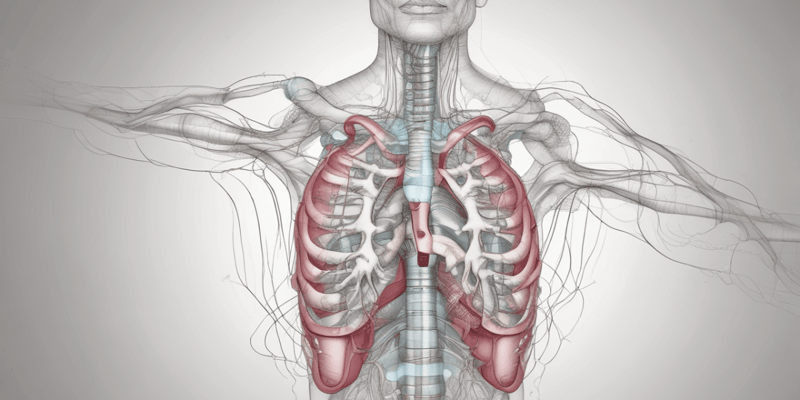17 Questions
What is the purpose of the serous fluid in the pleural space?
To allow the lungs to glide smoothly during ventilation
What is the characteristic of the pressure in the pleural space?
It is always negative
What is the result of the negative pressure in the pleural space?
The two layers of the pleura are sucked together
What is the role of the pleural space in breathing?
It helps to facilitate smooth lung movement
What would happen if the serous fluid in the pleural space were to decrease?
The lungs would move with more difficulty
What enables the lungs to move smoothly during ventilation?
The presence of serous fluid in the pleural space
What is the function of the negative pressure in the pleural space?
To suck the two layers together
What is the relationship between the two pleural layers during ventilation?
They slide past each other
What is the main characteristic of the pleural space?
It has a negative pressure
What is the result of the combination of the serous fluid and negative pressure in the pleural space?
The lungs move smoothly during ventilation
Ventilation = the physical movement of air between the outside environment and the lungs. Ventilation relies on two gas pressure gradients.
True
Respiration = a process resulting in the production of energy, typically with the intake of oxygen and the release of carbon dioxide in the tissues (at the cellular level). TPR – temperature, pulse, respiration
True
The alveoli are able to suck air in on their own due to the presence of muscle tissue.
False
The diaphragm is the only muscle involved in the inhalation process.
False
The vacuum in the pleural cavity helps to push the lungs away from the thoracic wall during inhalation.
False
Respiration is the physical movement of air between the outside environment and the lungs.
False
Inhalation is a passive process that does not require muscular contractions.
False
Study Notes
Pleural Space and Breathing
- A small amount of serous fluid in the pleural space enables the lungs to glide smoothly during ventilation.
- The negative pressure (vacuum) in the pleural space holds the two pleural layers together, facilitating breathing.
Pleural Space and Breathing
- Small amount of serous fluid in the pleural space enables lungs to move smoothly during ventilation
- Negative pressure (vacuum) in the pleural space holds the two layers of pleura together
- This negative pressure plays a crucial role in the breathing process
Ventilation Process
- Alveoli and surrounding tissues lack muscle tissue, making them incapable of drawing air in on their own.
- Inhalation is an active process that requires muscle contractions.
Muscles Involved in Inhalation
- Diaphragm: plays a crucial role in the inhalation process.
- Intercostal muscles: involved in the contraction process.
Thoracic Cavity
- The pleural cavity contains a vacuum that helps suck the lungs to the thoracic wall and diaphragm.
Learn about the functions of the pleural space, including the role of serous fluid and negative pressure in facilitating smooth ventilation and breathing.
Make Your Own Quizzes and Flashcards
Convert your notes into interactive study material.
Get started for free




